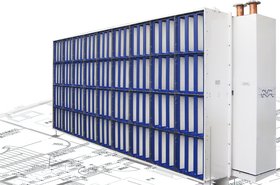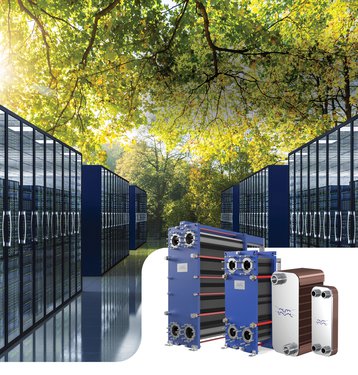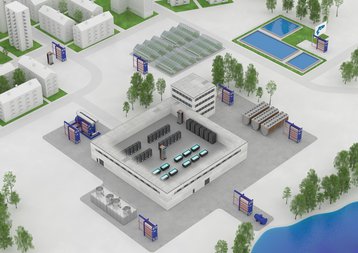These days everybody in the data center business wants to talk about energy efficiency. The goal is to achieve a PUE of 1.0; in other words, to build a data center where 100 percent of the energy used goes towards powering the servers themselves.
However, as much as 40 percent of today's data center energy consumption goes towards cooling operations; hence, more efficient cooling systems equal more sustainable data centers.
When it comes to minimizing data center energy consumption and environmental impact we can’t just focus on the white space. The key lies in the utility area. Many of the systems that supply cooling to the white space rely solely on chillers and waste incredible amounts of energy, while increasing operational costs.
Fortunately, the key to making these systems more sustainable already exists. Advanced plate heat exchanger technology, if properly designed, installed, operated and maintained, support highly reliable and highly efficient cooling with a long service life that can shrink both your environmental footprint and your bills.
“It’s really important to have the most efficient heat exchangers possible so that you don’t lose any temperature in the heat transfer,” says Anna Blomborg, Industry Manager Data Centers, at heat exchanger specialist Alfa Laval.
Heat exchangers can help achieve a PUE as close as possible to 1.0, while also addressing other key sustainability metrics such as CUE (carbon usage effectiveness), WUE (water usage effectiveness), and ERE (energy reuse effectiveness).
Re-using excess heat
With data centers increasingly being taken to task over energy consumption, one of the best ways to minimize energy usage is by recycling ‘waste heat’ for secondary applications.
“There is no such thing as waste heat if that heat can be re-used in other processes,” says Blomborg. “That’s why I prefer calling it excess heat.”
These secondary applications might include using excess heat used for growing tomatoes in commercial greenhouses; for farms producing fish, lobsters and other aquatic foods; but, most common of all, for district heating and cooling schemes.
In addition, with the legislative environment tightening, governments are increasingly demanding that data centers minimize use of energy and water. Heat reuse comes as a natural extension of this approach.
For example, in Denmark, in response to the influx of hyperscale data center operators tying up renewable energy contracts, the government has introduced new rules on heat reuse. In Norway, meanwhile, it is a legal requirement for any data center facility over a certain size and power usage to produce a report on heat reuse.
And, increasingly, governments will expect data center operators to do more than just stroke their chins over the potential for heat reuse, producing mere reports; they will demand action. In Stockholm, for example, data centers are already being designed so that they can contribute waste heat to the city’s district heating schemes.
In line with the global shift towards sustainability among data center operators, data centers in Asia-Pacific are embracing efficiencies. In Singapore, new data centers are required to have a PUE of less than 1.3, with highest certification attained for the local green building rating system – platinum.
In Malaysia, a green data center park featuring renewable energy by YTL is expected to be completed in 2024. In Australia, a system has been set-up to assess the sustainability factor in data centers, highlighting the areas that can be improved to be more energy efficient. With rising energy costs over the past year, data center operators have no choice but to explore all options to become more energy efficient.
Made to measure
Alfa Laval’s heat exchanger technology is focused on liquid-to-liquid transfer through heat exchangers, separators, pumps and valves. “We’re involved in all forms of heat rejection in liquid form,” says Blomborg.
The technology company’s products can be found in the food manufacturing, chemicals, and pharmaceuticals industries, among many others. It is even used in nuclear power, across the engineering sector and for treating wastewater.
On top of that, Alfa Laval is also investing in heat transfer technology that can be used in hydrogen fuel cells, thermal storage and carbon capture.
The company is even working with cutting edge energy tech companies such as Malta Inc, which is developing a grid-scale thermo-electric storage system using molten salt as a long-term energy storage system to complement renewable power.
The company has more than 3,700 patents.
“We do business with data center companies direct, and we also do business with cooling system integrators, who integrate the chiller and the cooling system,” says Blomborg. “A well-functioning heat exchanger is designed specifically for the duty it is supposed to perform. It needs to be exactly the right size to ensure maximum efficiency throughout the lifecycle.”
Ideally this performance is independently certified by the AHRI Liquid to Liquid Heat Exchangers (LLHE) Certification Program which ensures thermal performance according to manufacturers’ published specifications.
Liquid cooling
The global push to make data centers more energy efficient has seen a surge in interest in liquid cooling in its various forms, and immersion cooling in particular, especially in recent years.
When it comes to heat reuse, immersion cooling offers two distinct advantages. First, it enables data center operators to run their servers at much higher temperatures, enabling more compute power to be extracted from the same servers. Moreover, the heat generated is therefore higher, can also be directly captured and, hence, more easily reused.
“With immersion heating you can get much more interesting temperatures – maybe 50 degrees Celsius, 55 and possibly even 60 degrees. That’s good enough for tap water or taking a nice, warm shower. As an industry, these higher temperatures mean that you can do much more with the waste heat,” says Blomborg.
“In comparison, when you’re using air cooling, the return temperature is unlikely to be more than about 30 degrees, although that’s still useful to lift from heat pumps and reuse. That’s what a large data center in Denmark is doing, lifting it up and sending it out to contribute to district heating to heat 14,000 homes,” she adds.
On a more modest scale, she adds, it can be used directly to heat greenhouses, fish farms and even swimming pools with little enhancement required; or, at a minimum, can be used to heat the data center’s office and public areas. More than 90 percent of the energy can be reused, adds Blomborg.
Indeed, in the future, any economic activity that involves the creation of excess heat could be subject to regulations demanding heat reuse on the grounds of sustainability.
Going fully carbon neutral
As the world heads for carbon neutrality, Alfa Laval is also examining the company’s own production and supply chain processes in a bid to slash the carbon footprint of its own products.
One example is ‘green steel’, with developments already underway in Sweden to start making steel using hydrogen generated from wind and hydro power in place of coal. Commercial production is scheduled to begin from around 2026 – and Alfa Laval has a ticket in the queue that will make it among the first to use products made from ‘green steel’.
“We are the first heat exchanger company to sign up, so we will be the first to get green steel in our heat exchangers in the coming years,” says Blomborg.
Alfa Laval products are made to last. But when heat exchangers eventually reach the end of their lifecycle, Alfa Laval is developing new partnerships to guarantee ‘circularity’. For instance, the “Re-made to matter” initiative with Stena Recycling, which makes it possible to upgrade to a more energy-efficient heat exchanger and get a refund on an old one, which will then be recycled. The program is already available in Sweden, with other countries to follow soon.
Discover how Alfa Laval enables data center operators to help drive the transition to net zero by specifying Alfa Laval heat exchangers in the cooling systems they use. Visit www.alfalaval.sg/industries/hvac/data-center-cooling/
More...
-

Exploring data centers' free cooling potential
How heat exchangers can help your IT infrastructure grows sustainably.
-

Alfa Laval promotes the benefits of Low Speed Ventilation for data centers
The company thinks your fans are spinning too fast




